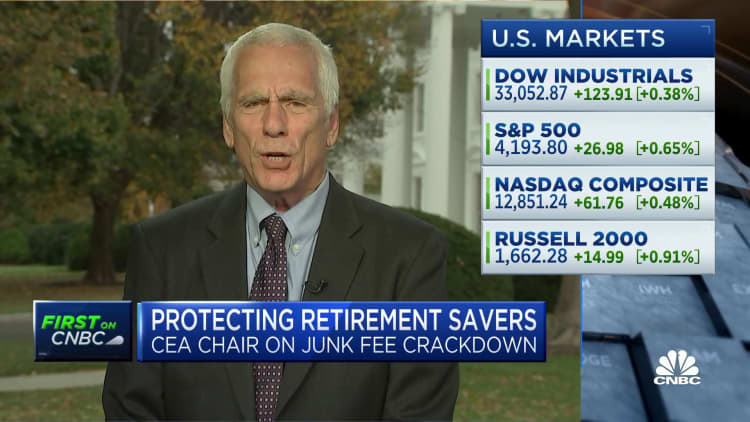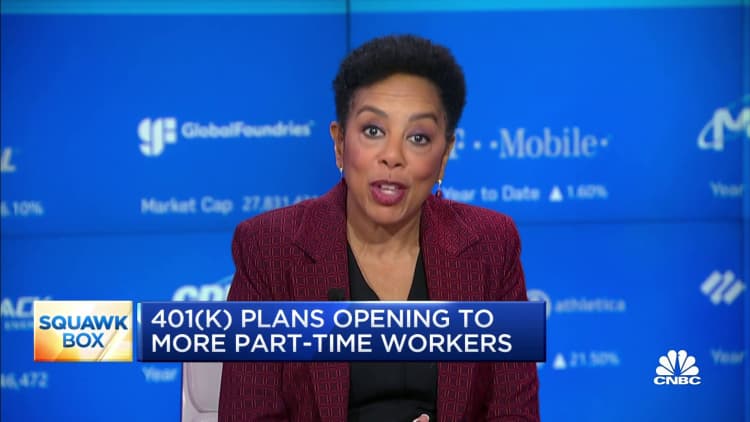
Team of millennial colleagues sharing ideas for new business start up, togetherness, innovation, diversity
10’000 Hours | Digitalvision | Getty Images
More workers are getting access to a Roth savings option in their 401(k) plans.
In 2022, 89.1% of employers that sponsor a 401(k) plan allowed workers to set aside money in a Roth account, according to a recent poll by the Plan Sponsor Council of America, a trade group.
That share has increased significantly over the past decade: Just 58.2% of employers made a Roth 401(k) available in 2013, PSCA found. It also rose slightly over the past year, from 87.8% in 2021.
More from Personal Finance:
Retirees face significantly higher Medicare Part D premiums in 2024
More part-time workers to get access to employer retirement plans next year
These behavioral traits lead to greater retirement savings
A Roth is a type of after-tax account. Workers pay tax up front on 401(k) contributions, but investment growth and account withdrawals in retirement are tax-free. This differs from traditional pretax savings, whereby workers get a tax break upfront but pay later.
“Offering Roth as an option is a relatively easy-to-administer customization that offers employees more flexibility in their retirement savings approach,” Hattie Greenan, PSCA research director, explained in an email. “Offering this choice has become a best practice over the last 10 years.”
Why workers may miss out on a Roth 401(k)
However, Roth uptake by employees remains relatively low by comparison: About 21% of workers made a Roth contribution in 2022, according to PSCA data. By comparison, 72% saved in a traditional pretax account. (Workers can opt to use either, or both.)
There are a few reasons why usage likely doesn’t correspond with overall availability.

For one, automatically enrolling employees into 401(k) plans has become popular: 64% of plans used so-called auto enrollment in 2021, PSCA found. Companies often choose pretax — not Roth — accounts as the receptacle for automatic contributions. That means workers would have to make a proactive decision to switch their allocation.
High earners may also mistakenly think there are income limits to contribute to a Roth 401(k), as there are with a Roth individual retirement account.
Roth accounts are poised to be more widespread
Employers that match 401(k) savings have historically done so in the pretax savings bucket, regardless of whether the employee contributions are pretax or Roth. But that’s changing: A retirement law passed last year lets employers offer their company match in a Roth account, if a worker elects that option. About 12% of employers with a 401(k) plan are “definitely” adding that feature, and 37% are “still considering” it, according to the PSCA survey.
“Many [employers] are seeing requests from employees for this option, and it is something we will see begin to take hold moving forward,” Greenan said.
The recently passed retirement law, known as Secure 2.0, is also expected to increase Roth uptake in another way. It will require “catch up” 401(k) contributions to be made to Roth accounts, if the worker’s income exceeds $145,000 (indexed to inflation).
Employers must make the change by 2026. Those that don’t already do so must allow Roth contributions to facilitate this change, or disallow catch-up contributions, according to Principal.
Catch-up contributions are available to people age 50 and older. Such workers are permitted to funnel an additional $7,500 into 401(k) plans in 2024, beyond the $23,000 annual limit.
When Roth 401(k), IRA savings makes sense
Roth 401(k) contributions may not be wise for all workers. Generally, they make sense for investors who are likely in a lower tax bracket now than they expect to be when they retire, according to financial advisors.
That’s because they would accumulate a larger nest egg by paying tax now at a lower tax rate.
It’s impossible to know what your tax rates or exact financial situation will be in retirement, which may be decades in the future. “You’re really just making a tax bet,” Ted Jenkin, a certified financial planner and CEO of oXYGen Financial, previously told CNBC. Jenkin is also a member of CNBC’s Financial Advisor Council.
However, there are some guiding principles for Roth.

For example, Roth accounts generally make sense for young people, especially those just entering the workforce, who are likely to have their highest-earning years ahead of them. Those contributions and any investment growth would then compound tax-free for decades. (One important note: Investment growth is only tax-free for withdrawals after age 59½, and provided you have had the Roth account for at least five years.)
Some may shun Roth savings because they assume both their spending and their tax bracket will fall when they retire. But that doesn’t always happen, according to financial advisors.
There are benefits to Roth accounts beyond tax savings, too.
For example, investors with Roth 401(k) savings won’t need to take required minimum distributions from those accounts starting in 2024. This already applies to Roth IRAs. However, the same isn’t true for traditional pretax accounts: Retirees must pull funds from pretax 401(k)s and IRAs starting at age 73, even if they don’t need the money.
Roth savings can also help reduce annual premiums for Medicare Part B, which are based on taxable income. Because Roth withdrawals are considered tax-free income, pulling money strategically from Roth accounts can prevent one’s income from jumping over certain Medicare thresholds.
Some advisors recommend allocating 401(k) savings to both pretax and Roth, regardless of age, as a hedge and diversification strategy.
Don’t miss these stories from CNBC PRO: